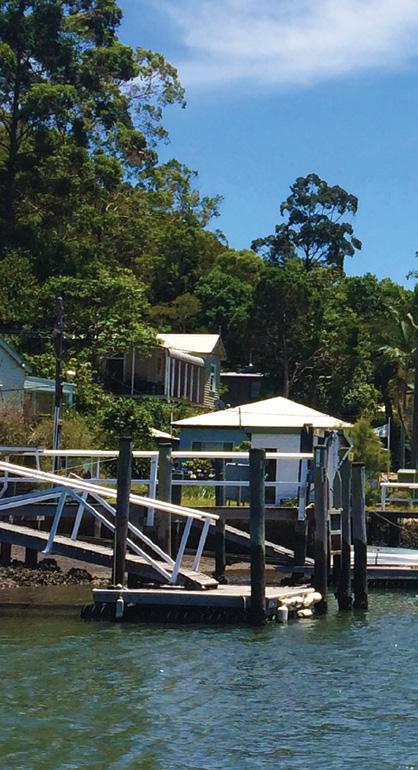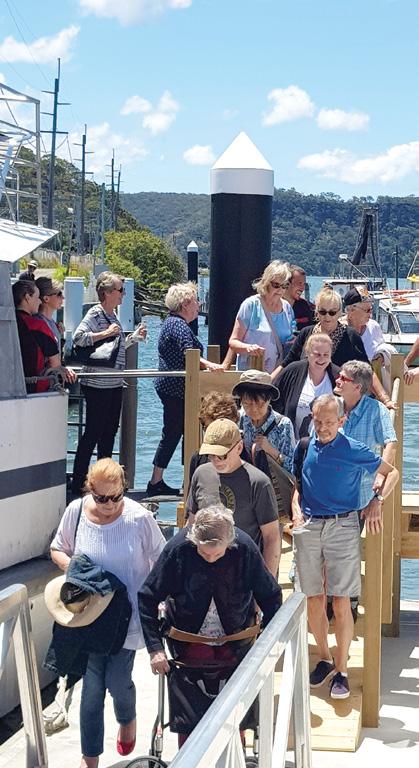
8 minute read
Counting on passenger safety
Counting onpassenger safety
Following changes to passenger safety requirements on 31 May 2020 Working Boats talked to the operators of two very different ferry services in New South Wales to find out how they manage the challenges of keeping an accurate count of passengers on board their vessels. Could any of these practices be applied to your operation?
Advertisement
By Simon Enticknap
Manly Fast Ferry
On Sydney Harbour, digital technology is playing a key role in monitoring passenger numbers on one of the busiest commuter routes in the country.
Every day, the Manly Fast Ferry service carries thousands of passengers on the 20-minute crossing between Manly and Circular Quay. During peak periods, there can be up to six departures an hour from the wharves, each ferry having just a few minutes in which to disembark and embark up to 400 passengers. It’s a high speed, fast turnaround operation with little room for error.
Three years ago, the operators of the service, NRMA, introduced an onboard electronic passenger number recording system that enables the vessels’ Masters and designated person ashore to get an instant overview of how many passengers are on board each boat.
Gavin Cooper, Marine Safety Business Partner at the NRMA, explained that as passengers embark, a crew member near the gangway counts each person. The data is then entered into an online system in the wheelhouse and is immediately available to the skipper as well as shore-based personnel who can log into the system.
‘As soon as we leave a berth we can instantly know how many people are on the boat. We’ve never had to use that information in an emergency but it’s always there,’ Gavin said.
The digital passenger number recording system has been standardised throughout the company’s operations. In addition to the Manly-Circular Quay fast ferry service, NRMA also operates a number of other ferry services on the harbour, including a Manly-Darling Harbour service, a two hour ‘hop-on, hop-off’ service around the harbour, as well as tourist cruises such as whale watching. Altogether, the fleet comprises 12 fast catamarans ranging from 19 to 33 metres in size.
On the tourist cruises, passengers are counted both on and off the vessel. In the unlikely event that the numbers don’t tally after an offshore cruise such as whale watching, staff would follow a set of procedures that escalate from an immediate recount, up to what would eventually be a full AMSA search.

Every passenger counts: Manly Fast Ferry carries passengers safely across Sydney Harbour; Passengers embarking on Manly Fast Ferry.
Images supplied

Passengers embark on the vessel
Fortunately, it’s never come to that— typically, any discrepancy is the result of somebody still being on the boat somewhere or a miscount, which can be quickly resolved. Offshore cruises also have a passenger manifest that is matched to the passenger count for extra assurance.
Gavin explained that digital passenger number recording is just one part of the company’s safety management system.
‘The safety management system— which is extensive to capture the conditions of their complex operation—has also been digitised and made searchable so that in any situation, such as a man overboard, a crew member can type in the appropriate keyword and instantly find the correct safety or emergency procedure,’ he said.
‘This also makes it easier to update and to pass along new information for training purposes.’
‘Taking everything online has really streamlined safety for us and made it accessible.’
While technology is a useful tool in managing passenger safety, Gavin also highlights the importance of crew training in maintaining a safe operating environment.
‘Nobody is allowed near operations until they’ve been through our own comprehensive training program, which we’ve developed over the years in conjunction with AMSA and other stakeholders,’ he said.
A policy of promoting staff from within the company also helps to foster a shared safety culture, which extends from the general purpose hands all the way up through the ranks to the vessel Masters.
The Riverboat Postman
North of Sydney on the Hawkesbury River there’s a ferry service that runs at a very different pace compared to the Manly Fast Ferry. The Riverboat Postman service based in Brooklyn, has been running since 1910, servicing the local communities on the Hawkesbury River only accessible by water. Every weekday, the ferry makes a three-hour round trip of the various remote villages, delivering mail and providing a vital communication lifeline to the 600 residents who live on the Hawkesbury.
As well as being an official Australia Post service, it is also a popular tourist cruise with up to 100 passengers going on the round trip to explore the Hawkesbury.
Since 2012, the service has been run by Hawkesbury Cruises, which also runs day cruises and other ferry services.The company operates three vessels, two catamarans and a monohull ranging from 15 to 25 metres.

Accurate passenger numbers: Riverboat Postman vessel Zarapito at the train bridge on the Hawkesbury.

Passengers disembarking the ferry onto the wharf
Images supplied
For the transfers to Milson Island, Broken Bay camp and Dangar Island, managing passenger numbers is relatively straightforward. Everybody is click-counted on board and then remains seated at all times. It is a very controlled environment, making counting much easier.
However, for the Riverboat Postman run, the nature of the service poses a different challenge. With numerous stops along the way allowing people on and off, as well as up to 450 items of mail to deliver, there’s the potential for crew to get distracted and miss someone.
‘There’s always going to be human error,’ says Justin Pigneguy, Hawkesbury Cruises owner.
‘Even if you have someone counting using a clicker counter, which is the method that’s been used for years, it’s not always 100 per cent accurate. You’ve only got to take your eyes off the gangway for two seconds and you can’t be sure you’ve counted everyone,’ he said.
To safeguard against such errors, the company uses a three-part system. Passengers who buy tickets are given a numbered boarding pass which they hand over to a crew member on the gangway. At the same time, the skipper separately counts the number of passengers boarding.
Before departure, the number of passes handed out and received, plus the manual count must all tally, otherwise a recount takes place. The final number is recorded in the ship’s log and the shore log. During the journey, passengers getting on and off at different stops are also recorded in the logbook.
To ensure all passengers are present at the end of the voyage, skippers have been trialling the use of a manual hand clicker to count passengers as they disembark.
‘Skippers have reported that this system works well. They position themselves in the wheelhouse or other location that provides a good vantage point, without getting in the way of passengers as they get off,’ Justin said.
During the cruise, passengers remain seated during the initial safety briefing but are then free to move about the vessel. To date, there have been no incidents of passengers going missing but, in the event that it does happen, the crew have a set procedure to follow.
This includes quickly identifying who is missing and when they were last sighted, maintaining an open communication line with the shore-based manager at all times, retracing the route taken and informing the local water police and marine rescue of a potential man overboard.

Passengers disembarking the ferry onto the wharf.

Passengers disembarking the ferry onto the wharf.
Justin paid credit to his crew members for the fact that there have been so few safety incidents during his time on the Riverboat Postman, particularly given the advanced years of many of the passengers.
Training also plays an important role in this regard, with the company running monthly drills—either underway or at the wharf—for all skippers and deckhands. One of the most useful, says Justin, has been teaming up with local rural fire services to run training drills on the vessels.
‘We do training with them using portable fire extinguishers so the crew get an idea of what it’s like to fight a real fire. It’s been really invaluable to get that experience.’
Regulatory requirements concerning passenger counts
AMSA introduced a series of changes to regulatory requirements on 31 May 2020 to enhance passenger safety on domestic commercial vessels carrying passengers.
From 31 May 2020 passenger vessel operators must do the following:
Have a procedure in their safety management system that provides an effective and verifiable means of passenger monitoring to ensure the master of the vessel is able to find out the number of passengers on board the vessel at any time.
Have an emergency procedure in their SMS for responding to a situation where a passenger is unaccounted for.
For certain types of operations, have a procedure for counting passengers at specified points to ensure an accurate number of passengers embarking and disembarking the vessel.
This will include a count:
• at or around the time passengers embark and disembark the vessel at the start and end of voyage, or at an intermediate stop, and
• before departing any point where passengers have disembarked for a water activity such as diving, snorkelling or swimming
Record passenger counts in the vessels logbook.
The types of operations where a passenger count is required to be undertaken at embarkation and disembarkation are:
Class 2 vessel that is permitted to carry passengers or a Class 1 vessel that is permitted to carry no more than 75 passengers, and
is engaged on a voyage of at least 30 minutes scheduled duration and no more than 12 hours scheduled duration, and the vessel is not scheduled to stop for embarkation or disembarkation in the first 30 minutes, and
is operating in B, C or D water, or E waters outside of daylight hours.
More information: Regulatory changes aimed to improve passenger safety on domestic commercial vessels: amsa.gov.au/improve-passengersafety
Learn more about operational areas at: amsa.gov.au/service-categories








